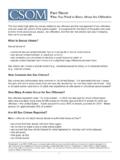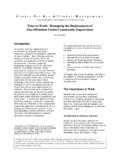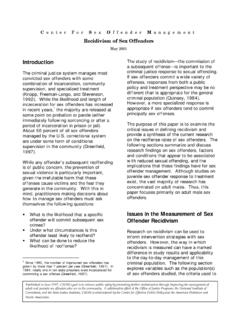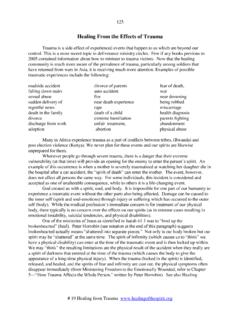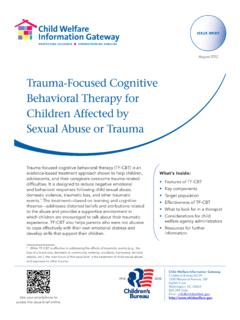Transcription of The ABCs of Managing Secondary Trauma—
1 Section 3 Handout The abcs of Managing Secondary trauma The abcs of Managing Secondary trauma Awareness, Balance, and Connection1 Being aware of how our work can impact us, and achieving and maintaining a sense of balance and connection in our lives, can prevent us from experiencing Secondary trauma and/or mitigate its harmful effects. Listed below are several ways in which you can decrease your risk of experiencing or reduce the impact of Secondary trauma . Awareness Know your own trauma map. Acknowledge your own history of trauma and be aware that it can affect how you view and do this work.
2 Inventory your current lifestyle choices and make necessary changes. Do you get enough sleep? Do you allow yourself downtime? Do you exercise regularly? Try to do these things. Take care of yourself. Create a self-care list and post it prominently in your home or office. A sample self-care list may encourage you to: o Be creative; o Get away; o Get outside and appreciate the weather; o Enjoy other environments; o Have fun; and o Socialize with people who aren t criminal! Balance Give yourself permission to fully experience emotional reactions.
3 Do not keep your emotions bottled up. Maintain clear work boundaries. Avoid working overtime and do not spend all of your free time socializing only with coworkers, discussing the negative aspects of your job. Set realistic goals for yourself. Know your limits and accept them. Learn and practice time management skills. These skills will help you achieve a sense of balance in both your professional and personal lives. Seek out a new leisure activity. Choose a leisure activity unrelated to your job. Recognize negative coping skills and avoid them.
4 Substitute these coping skills with the more positive coping skills included in your self-care list! Connection Listen to feedback from colleagues, friends, and family members. Have a family member or friend conduct periodic pulse checks. Avoid professional isolation. While it is best to not spend all of your time with coworkers, it is beneficial to be connected with and supported by your coworkers on the job. Debrief after difficult cases. Now is the time to talk to and connect with another coworker! Develop support systems.
5 Start an informal peer support group, seek out a mentor, or be a mentor to someone else. Seek training to improve job skills and capacity. Training will not only allow you to stay abreast of new issues emerging in the field but will also allow you to connect with others who do this work Remember your spiritual side. While often neglected when stress occurs, this aspect can be most helpful to coping with Secondary trauma . Center for Sex Offender Management Secondary trauma and the Management of Sex Offenders in the Community Section 3 Handout The abcs of Managing Secondary trauma 1 Adapted from Saakvitne, K.
6 & Pearlman, L. (1996). Transforming the Pain: A Workbook on Vicarious Traumatization for Helping Professionals who Work with Traumatized Clients. New York, New York: Norton and Company. Center for Sex Offender Management Secondary trauma and the Management of Sex Offenders in the Community Page 2 of 2
